Part 3 of 3 of the Article Series: Understanding Omnichannel Pharma Marketing
In recent years, omnichannel pharma marketing (OCM) has emerged as a pivotal development in the pharmaceutical market. In this article series, we aim to provide comprehensive insights into OCM, covering the following key aspects:
1. What is Omnichannel Pharma Marketing?
2. Why is Omnichannel Pharma Marketing so relevant for pharmaceutical companies right now?
3. How does Omnichannel Pharma Marketing work?
Part 1: Customer Journey in Omnichannel Pharma Marketing
Part 2: Channels in Omnichannel Pharma Marketing
Part 3: Data Management in Omnichannel Pharma Marketing
4. The Advantages of Omnichannel Pharma Marketing
5. What Impact does Omnichannel Pharma Marketing have on the Success of Pharmaceutical Companies?
+ Whitepaper: Implementation of Omnichannel Pharma Marketing
Whether it's coordinating the various marketing and sales channels, optimizing sales force resources, or gaining a detailed understanding of the target group - data management plays a central role in the omnichannel approach. When used correctly, it becomes a key driver for the success of pharmaceutical companies. That's why in this article, we take a closer look at the three most important components of data management in omnichannel pharma marketing (OCM):
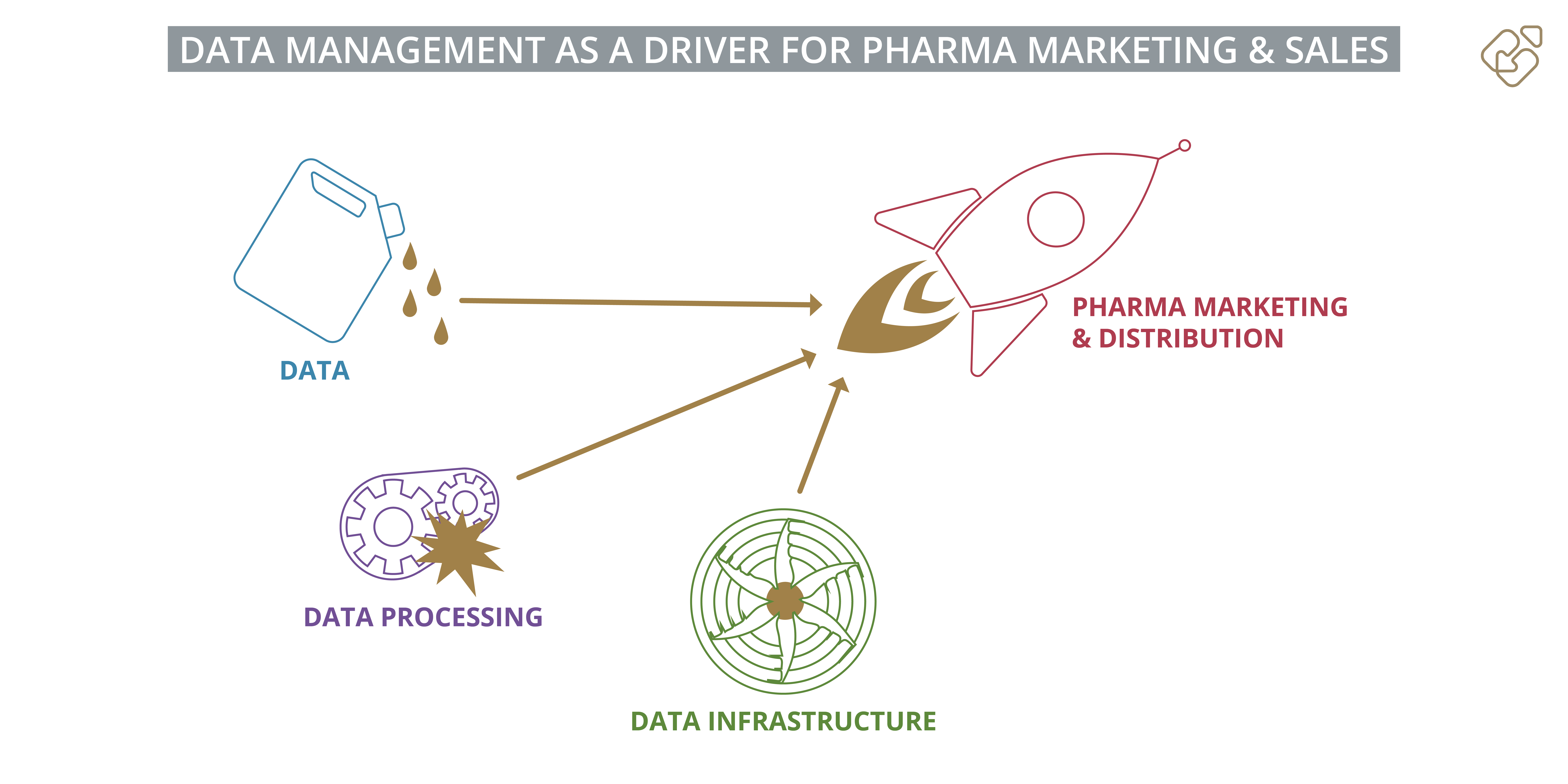
1. Types of Data in Omnichannel Pharma Marketing
The first component is the data itself. In data management, data can be imagined as the fuel that drives the process. Let's begin by identifying the data particularly relevant in OCM and then explore how it is utilized in practice. The value of this data is always measured by the decisions it improves. Accordingly, we have divided the data into three groups, each reflecting the decision area on which it has the most influence:
a) Data on Potential
This group focuses on data that helps determine the value of leads for sales. From it, pharmaceutical companies can accurately assess the future revenue potential for a particular physician or medical facility (e.g., practice, hospital) by considering three crucial factors:
- Prescription potential: The first factor is the number of prescriptions a physician or facility can theoretically make. This can be estimated based on the current number of prescriptions, the clinic's size, the number of patients treated, etc.
- Probability of success: This describes the chances of influencing the physician's treatment decision and persuading them to consider a change of therapy. Criteria such as awareness of a specific indication, satisfaction with competing products, and willingness to test alternatives play a key role here. While some data cannot be precisely quantified, assessments from sales staff provide an important starting point for approximating a physician's probability of success. With the help of standardized evaluation criteria, the sales force can better categorize aspects such as the quality of interactions or an institution's openness to innovation and incorporate them into the customer profile. In addition, data from digital activities (e.g., interaction frequency and duration) offer further insights into the relationship between physician and company and the willingness to change therapy. The goal is to enrich the customer profiles with as many data points as possible to draw new insights from linking these insights. In OCM, the totality of all the data thus produces a meaningfulness that is significantly greater than the information content of its individual parts.
- Indirect potential: When making important decisions, physicians often rely heavily on the experiences and opinions of their peers and key opinion leaders within their field. Our evaluations of physician decision-making during therapy changes have consistently shown that interactions with colleagues significantly impact their choices. To determine the indirect potential of a physician, several important indicators come into play. Information about a physician's position (e.g., senior physician), the size of their medical practice or ward, and their reputation on platforms like Medscape, all play crucial roles. Additionally, their participation and roles as speakers at congresses and seminars can offer valuable insights. By evaluating these indicators and understanding the influence physicians have within their professional network, pharmaceutical companies can devise more effective strategies to engage with physicians and leverage their indirect influence to drive positive outcomes for their products and services.
Additionally, reference data, such as current and historical sales figures, is extremely valuable for realistically assessing the potential of target customers. By comparing with values of similar physicians, pharmaceutical companies can estimate the potential of new target customers.
- Prescription potential: The first factor is the number of prescriptions a physician or facility can theoretically make. This can be estimated based on the current number of prescriptions, the clinic's size, the number of patients treated, etc.
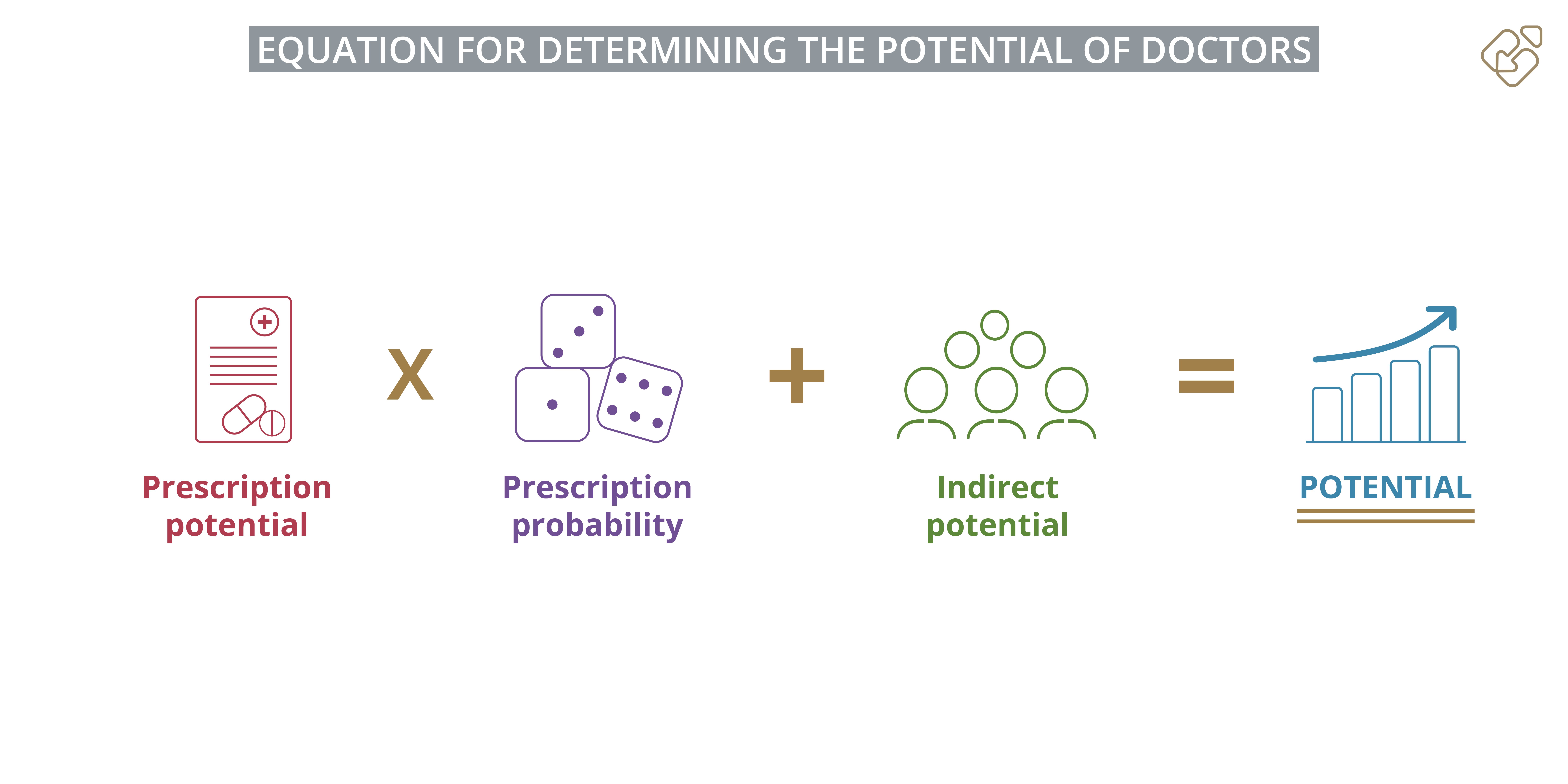
The influence of data on potential in OCM:
The potential of target customers provides a crucial basis for resource planning and prioritization in sales and marketing. Accurate assessments of potential enable pharmaceutical companies to optimize their resource allocation by focusing on physicians who deserve special attention. The potential data also aids in segmenting physicians into different groups for which appropriate customer journeys can be designed.
b) Data on Needs
The second group includes data that helps assess the needs, preferences, interests, and challenges of medical professionals. This data is vital for understanding the target group and enables essential functions of OCM, such as customizing the customer journey, personalizing content, or choosing the right channels. Two types of data play a major role here:
- Physician's demographic data: This includes basics like geographic location, specialty, position, and the institution where a physician works. Age is also crucial, as it can influence information behavior significantly.
- Interaction data: This includes all responses and interactions a physician has with the company's marketing and sales activities. Data collected from various touchpoints, such as newsletter open rates, clicks on Google and social media, landing page visits, seminar attendance, video views, articles read, etc., form a detailed picture of each physician. Additionally, information from sales meetings and customer service interactions are valuable sources, too. Sales staff logging their sales contacts in a standardized way via a simple interface (e.g., IQVIA OCE) makes such data analyzable, while digital sales tools, like E-detailing, track key messages from sales meetings.
- Physician's demographic data: This includes basics like geographic location, specialty, position, and the institution where a physician works. Age is also crucial, as it can influence information behavior significantly.
The influence of data on needs in OCM:
Physicians' needs play a critical role in guiding marketing and sales planning, particularly at the tactical level. Decisions about content, formats, and channels best suited to specific physicians are based on understanding their needs. At the same time, they allow sales representatives to customize individual meetings by selecting appropriate topics and sales documents. To this end all the data collected is linked to a central customer profile, enabling employees throughout the company to access the needs data of respective physicians.
c) Data on Decision-Making Phases
Using the Customer Journey, we have shown how the choice of appropriate channels and content in communication can differ significantly depending on where physicians currently are in their decision-making process. The third group therefore includes all data that provides information about the current decision-making phase of the target group.
- Tracking data plays a vital role in understanding a physician's decision-making process. Through careful tracking of interactions, such as website visits, content clicks, and whitepaper downloads, valuable insights can be gained. For instance, identifying leads who consistently seek information on a specific topic or understanding a physician's intent based on their engagement with study data or application examples can be crucial. Digital touchpoints, like Google ads, even provide insights into the exact search intent, offering direct information on what a physician wants. Ensuring clean and accurate data tracking, along with proper assignment to the correct customer profile, is essential to derive meaningful conclusions.
- Additionally, sales data collected by the field sales force offers indispensable insights into the decision-making phase, too. Direct customer interactions provide valuable context, enabling sales representatives to assess a physician's level of knowledge on a particular topic and where they stand in the decision-making process. This valuable data allows pharmaceutical companies to tailor their communication and marketing strategies effectively to the decision-making phase physicians are currently in.
- Tracking data plays a vital role in understanding a physician's decision-making process. Through careful tracking of interactions, such as website visits, content clicks, and whitepaper downloads, valuable insights can be gained. For instance, identifying leads who consistently seek information on a specific topic or understanding a physician's intent based on their engagement with study data or application examples can be crucial. Digital touchpoints, like Google ads, even provide insights into the exact search intent, offering direct information on what a physician wants. Ensuring clean and accurate data tracking, along with proper assignment to the correct customer profile, is essential to derive meaningful conclusions.
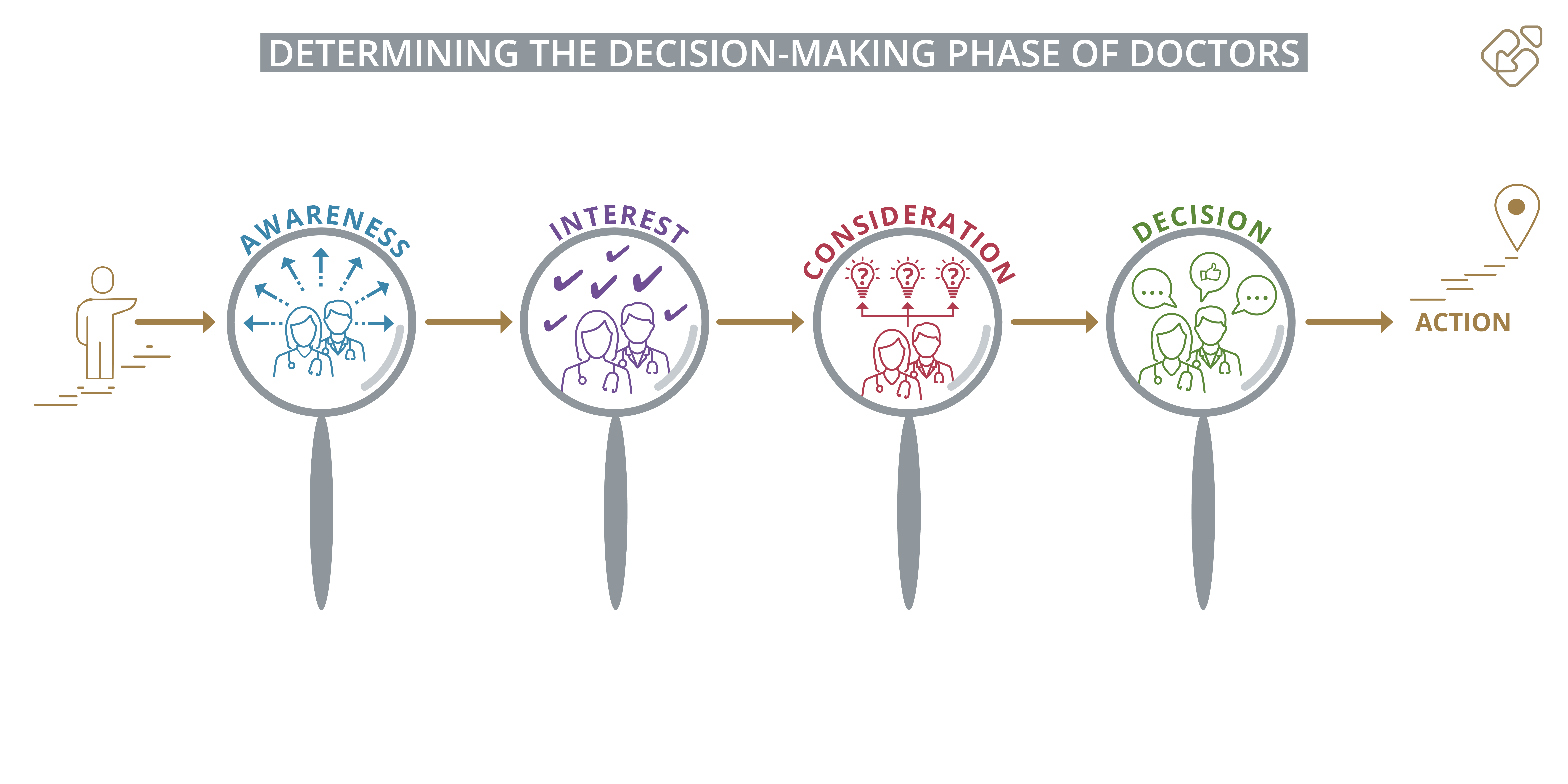
Influence of Data on Decision-Making Phase in OCM:
The influence of decision phase data in omnichannel pharma marketing (OCM) is of immense importance when it comes to timing marketing and sales efforts effectively. Each phase of the customer journey brings significant changes in a physician's needs. For instance, in the initial stages, physicians are primarily seeking information on a topic. Bombarding them with excessive product-related details might deter them and erode trust. By contrast later, such information becomes highly relevant when they are already contemplating a change of therapy. The key objective here is to precisely identify the needs of potential prescribers at any given moment and respond accordingly. In achieving this, detailed data plays a crucial role, aiding in the clear identification of decision-making phases and developing the necessary sensitivity to address the current needs of the target group.

FREE WHITEPAPER
How to Implement Omnichannel Pharma Marketing in Practice?
- 5 Steps to Success - OCM Implementation Roadmap
- 5 Best Practices in Successful OCM Implementation
- 3 Success Factors that make the Difference in Practice
Use of Data in OCM Practice
So how can we imagine the practical use of this data? Particularly in the early phases of the customer journey, providing individualized support to each doctor is often not feasible. On one hand, the level of detail in the information collected at this stage is typically not yet sufficient to enable meaningful personalization of measures. On the other hand, efficiency comes into question. In most instances, individually tailoring marketing and sales measures exceeds the capacity of available resources. Personalization so early in the customer journey is only feasible for very specific target groups comprising a few hundred doctors (e.g., in reproductive medicine).
For this reason, the omnichannel approach relies on smart clustering of target doctors, by segmenting leads with similar characteristics into common groups. This offers the advantage that certain measures, content, and sequences in the customer journey can be reused for all doctors within the same cluster. In this way, pharmaceutical companies create a healthy balance between efficient use of resources on the one hand and adaptation to the target group on the other.
To segment their target group as meaningfully as possible, it is advisable to link the above-mentioned data types with each other to sort target doctors into multi-dimensional clusters (see example in the graphic).
Of course, clustering does not mark the end point for personalisation in OCM. After all, the more data is collected and the closer the relationships with doctors become, the more opportunities there are for needs-based targeting. Customer profiles become more detailed over time as they are enriched with information from numerous interactions. In addition, as doctors move from one decision phase to the next, their potential tends to increase, making targeted, individual support more worthwhile, especially to the sales force. In parallel, automating sequences within the customer journey can help to react flexibly to interaction data (e.g. clicks on certain newsletter content) and gradually adapt the communication to the respective doctor.
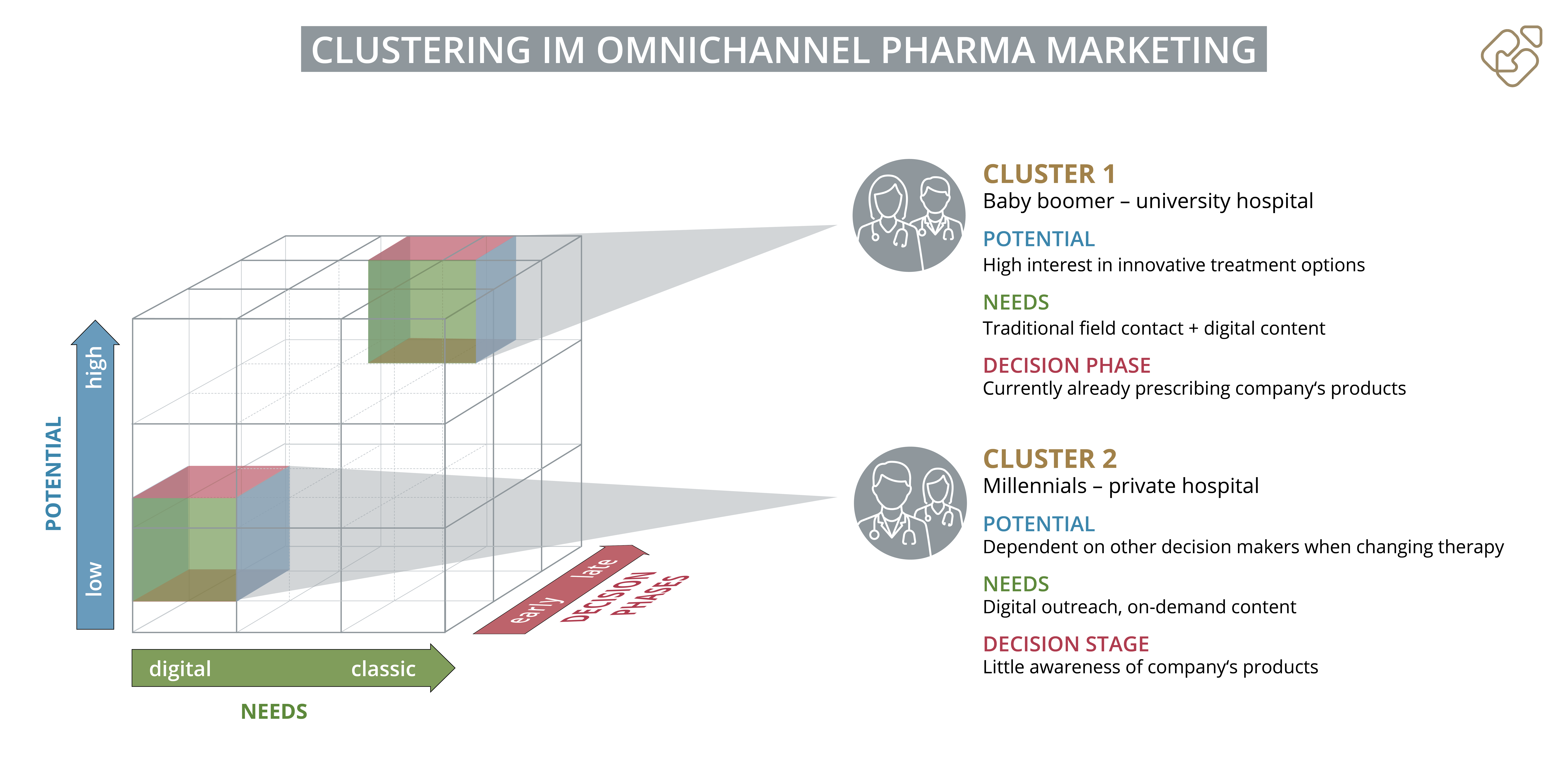
2. Data Processing in Omnichannel Pharma Marketing
To harness the potential of data in omnichannel pharma marketing (OCM), effective data processing plays a central role. It involves transforming raw data into valuable information that can drive decision-making. The richer and more specific the information derived from data, the more valuable it becomes as a tool for pharmaceutical companies. Let's explore the three essential components of data processing in OCM:
a) Data Acquisition
The first step in data processing is to systematically collect the available data. In doing so, pharmaceutical companies lay the foundation for all subsequent processing steps. After all, the quality of the data collected determines the quality of the information that can be extracted from it. A principle often referred to in computer science as "garbage in, garbage out." Two aspects are particularly important in the collection process:
- Data coverage: The first critical aspect of data acquisition, involves the comprehensive collection of information from various channels and contact points. Digital channels like websites require clean tracking to identify users and monitor their activities (e.g., pages visited, clicks), while the field force needs an efficient process for documenting conversations and content generated during interactions. Automation can be beneficial in streamlining documentation, ensuring data accuracy, and saving time (e.g. when it comes to the content of the sales presentation that was discussed or the subsequent follow-up via email).
- Data linking: The second aspect of data acquisition is about the ability to assign the data collected to individual customer profiles. The goal is to link all pieces of information in to create a detailed picture of each physician. Here Customer Relationship Management (CRM) systems, like IQVIA OCE, Veeva, and Salesforce, play a key role as they provide the infrastructure to connect different data sources (e.g. marketing tools and channels) and provide a hub for data aggregation and organization.
- Data coverage: The first critical aspect of data acquisition, involves the comprehensive collection of information from various channels and contact points. Digital channels like websites require clean tracking to identify users and monitor their activities (e.g., pages visited, clicks), while the field force needs an efficient process for documenting conversations and content generated during interactions. Automation can be beneficial in streamlining documentation, ensuring data accuracy, and saving time (e.g. when it comes to the content of the sales presentation that was discussed or the subsequent follow-up via email).
b) Data Evaluation
Once data is collected, the next step is to extract relevant information for sales and marketing management. Two dimensions are distinguished in the evaluation process:
- Horizontal analysis: This involves aggregating data from various profiles to measure the effects of specific actions across the entire cohort (e.g., the effectiveness of an e-mail campaign through registrations for a seminar). Horizontal analysis is useful for comparing different clusters and optimizing the approach tailored to each cluster's needs.
- Vertical analysis: Vertical analysis examines the customer journey of individual leads to identify patterns that provide insights into physicians' needs and interests, potential, as well as their current decision-making phase. The main aim is to anticipate what will be relevant to the physician at any given moment to adapt marketing and sales measures accordingly. Consequently, vertical analysis constitutes an essential step for individualizing the approach toward high-potential doctors.
- Horizontal analysis: This involves aggregating data from various profiles to measure the effects of specific actions across the entire cohort (e.g., the effectiveness of an e-mail campaign through registrations for a seminar). Horizontal analysis is useful for comparing different clusters and optimizing the approach tailored to each cluster's needs.
By employing these dimensions, pharmaceutical companies gain valuable insights that address the three fundamental Ws of sales and marketing management:
1. Who - for which physicians or clusters of physicians is it relevant?
2. What - which channels, which content, and which measures should be used?
3. When - at what stage or moment will it be most effective?
c) Data-Based Decision-Making
To harness the full potential of data collected, pharmaceutical companies must ensure that employees consistently utilize the information for decision-making. In OCM, four crucial factors are involved in achieving this:
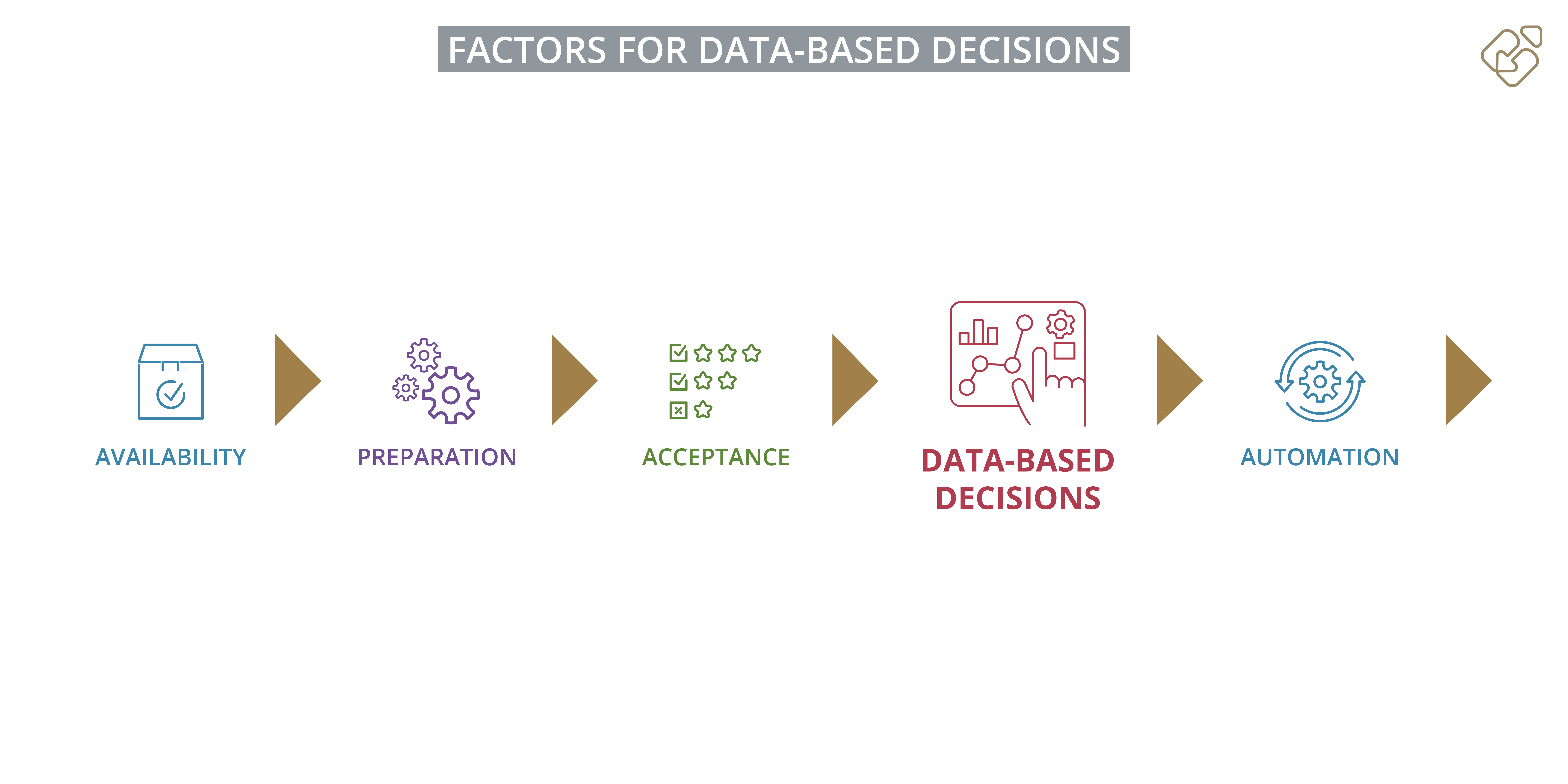
1. Availability: Making relevant information about target customers accessible to employees across different roles is a cornerstone of OCM. The physician's profile acts as a central hub to gather and disseminate this data throughout the organization.
2. Preparation: Merely providing access to data is insufficient; it must also be presented in a user-friendly manner. Many CRM systems therefore offer personalized user interfaces tailored to specific roles (e.g. giving key account managers an overview of essential customer metrics). Advanced systems (such as IQVIA OCE) take this even a step further by generating specific suggestions (e.g. on topics or actions) for employees - the so-called „next best actions“. These help to simplify decision-making and allow employees to focus on implementation.
3. Acceptance: Addressing the mindset of employees is vital in OCM. To embrace data-driven decision-making, employees must trust in the value data brings to their work and understand how it enhances efficiency and effectiveness. Involving employees in the development of new systems and considering their needs and work processes is crucial for fostering this acceptance.
4. Automation: Embracing digitalization offers the opportunity to automate certain processes in pharmaceutical sales and marketing, saving time and allowing employees to concentrate on core activities. Marketing automation plays a significant role in segmenting target groups into clusters and allocating resources, such as sales staff, to specific leads. Modern software, utilizing intelligent algorithms, can analyze customer profiles and make data-driven allocations, allowing sales representatives to focus wholeheartedly on customer interactions.
3. Data Infrastructure:
Data infrastructure acts as the engine driving the collection, processing, and utilization of data in (OCM). This vital component encompasses all technical systems and tools necessary for data management. Let's delve deeper into how the data infrastructure empowers these three critical processing steps:

a) Collect Data
Efficient data capture is crucial to OCM, as it involves linking diverse channels through an interconnected data infrastructure. Central to this integration is the customer profile, which consolidates data collected from touchpoints across diverse channels related to individual physicians. For this purpose, pharmaceutical companies work with CRM systems, which help them to effectively document and manage customer contacts. CRM systems such as IQVIA OCE, Veeva, and Salesforce therefore form the foundation of the data infrastructure. While implementing OCM doesn't always necessitate a complete system switch, it often requires adjustments, especially when different teams use varied systems. Expanding functionalities, such as managing interfaces between responsibilities and broadening customer profiles, can prove worthwhile.
In general, data collection falls into two primary groups:
- Automated collection: This includes the collection of digital data, such as website traffic, Google performance data, social media metrics, online advertising data, and e-detailing. However, automatic capture doesn't mean data generation requires no effort. Setting up clean interfaces and comprehensive tracking is essential:
Interfaces play a vital role in connecting different marketing tools, such as Google, Meta, and Active Campaign, to the company's CRM system, ensuring that customer profiles are enriched with digital performance data from various channels, including the website, Google, social media, and email. The good news is that most commonly used tools and CRM systems offer standardized interfaces (APIs) for data transfer, minimizing the need for extensive development efforts.
Tracking is essential for recording physicians' activities on the company's digital marketing and sales channels, encompassing clicks, views, downloads, and more. In OCM, the ability to link this data to individual customer profiles is crucial to tracking physicians' journeys across various touchpoints. For instance, tracking enables insights into how a physician, let's say, Dr. X, opened emails A, B, and C, read articles D and E on the website, and participated in webinar F. To accomplish this, pharmaceutical companies need a sophisticated tracking concept that defines what data is collected, where and how it's gathered, and how it's attributed to individual customer profiles. This concept also involves selecting appropriate tracking tools, like Google Tag Manager and Mixpanel, and devising customized solutions aligned with the specific marketing strategy.
- Manual collection: The data infrastructure should also support the manual collection of classic sales and marketing data, especially during field sales activities. For this purpose, common CRM systems offer tailored user interfaces, through which sales employees can directly record interactions with physicians. This step may require adjustments to align with the company's higher-level data strategy, such as categorizing qualitative information (e.g. innovation affinity) for quantitative evaluation (e.g. success probability for testing a new therapy).
b) Process Data
When it comes to analyzing customer data, business intelligence (BI) plays a central role. BI systems (e.g., Power BI, Tableau, Apteco Marketing Suite, minubo BI, SAP BusinessObjects BI) offer pharmaceutical companies software solutions that specialise in examining large volumes of data for useful patterns or correlations. An example for an application that is particularly relevant in pharma marketing is the segmentation of target groups into cohorts and clusters with similar needs. With the help of clever algorithms, the collected customer data is systematically evaluated for this purpose and valuable information is obtained for sales and marketing.
However, it is not only software that determines the effectiveness of data processing; the company's data strategy is just as relevant. Even the most sophisticated software can only generate meaningful information if the quality of the underlying data is assured. In addition, companies must clearly define beforehand which decisions shall be supported by data and which concrete information is required to make these decisions. This is where hypothesis testing comes into play, which uses hypotheses to define which relationship between the data (e.g. click rates on blog posts to newsletter sign-ups on the website) will be investigated, how this will be measured, and how the results will be evaluated. The more concretely these hypotheses are formulated, the more clearly the results can be interpreted at the end.
c) Use Data
The final step involves preparing the gathered information to optimize decision-making. Two options are available:
- Technology-assisted decision-making: The first option focuses on leveraging technology to optimize employee access to relevant information. User-friendly dashboard tools like Google Data Studio and IQVIA Apollo are employed to selectively prepare information, systematically supporting their day-to-day activities. These dashboards provide overviews of critical leads and sales contacts, prioritize tasks and contacts, and offer data-based suggestions such as follow-up actions and topic recommendations. Importantly, each dashboard is tailored to the specific roles and responsibilities of individual employees. This technological approach empowers pharmaceutical companies to actively promote data-driven decision-making, freeing employees from tedious data analysis and research tasks so they can concentrate on interpreting and implementing insights effectively.
- Automated decision-making: The second option takes things a step further, advocating for the automation of certain aspects of the decision-making process. Smart tools like SF Marketing Cloud, Active Campaign, and Zentrix interpret business intelligence information automatically to drive specific sales and marketing activities, such as email automation and field resource management. It is crucial to understand the division of labor between technology and people when using such automation tools. Although the software can handle some decision-making independently, it still requires oversight and management by the pharmaceutical sales force. Decision paths and parameters need to be defined in advance. In practical terms, automation tools take over some decision-making processes in day-to-day operations, but the strategic framework behind these decisions, including data strategy and customer journey, remains the responsibility of human decision-makers. The goal of automation is not to replace human control but to streamline repetitive tasks, allowing employees to concentrate on strategic matters and direct customer interactions.
- Technology-assisted decision-making: The first option focuses on leveraging technology to optimize employee access to relevant information. User-friendly dashboard tools like Google Data Studio and IQVIA Apollo are employed to selectively prepare information, systematically supporting their day-to-day activities. These dashboards provide overviews of critical leads and sales contacts, prioritize tasks and contacts, and offer data-based suggestions such as follow-up actions and topic recommendations. Importantly, each dashboard is tailored to the specific roles and responsibilities of individual employees. This technological approach empowers pharmaceutical companies to actively promote data-driven decision-making, freeing employees from tedious data analysis and research tasks so they can concentrate on interpreting and implementing insights effectively.

Free whitepaper
Challenges in Healthcare Sales 2024
- The biggest Challenges in Healthcare Sales 2024
- The hottest Trends in Healthcare Marketing
- What Sales Experts Wish For
Software selection
When it comes to selecting the specific tools and systems for the data infrastructure in OCM, pharmaceutical companies should take three factors to heart. This is because the selection of the appropriate solution is highly individual for each organization:
1. Existing systems: In general, it is advisable to first conduct an inventory of the status quo to determine what functionality the existing infrastructure offers. In this way, it is possible to build on the strengths of established processes and structures as well as on the data already available instead of completely reinventing the wheel. The infrastructure can then be expanded piece by piece and, where necessary, replaced in a targeted manner, without directly overturning everything.
2. Corporate structure: At the same time, the structure of the company also plays a decisive role in setting up the appropriate infrastructure. For example, the complexity of a medium-sized business differs significantly from that of a globally active corporation. Just as important is the scope of the omnichannel project - does it first cover specific product groups or markets, or does it cover the company as a whole?
3. Strategy and culture: Last but not least, strategic and cultural factors have a major influence on which data infrastructure fits the company. On the strategic level, aspects such as the mix between different sales and marketing channels, the data and communication strategies, and the product types (e.g., Rx, Gx, OTC, etc.) play an important role. At the cultural level, issues include decision-making processes, employee authority and responsibilities, and internal communication structure. Together with legal issues (e.g. compliance, GDPR, etc.), all these factors need to be included when selecting technical solutions.
EXPERT
Nicole Ehrhardt – Partner & Business Director

Erfolgreiches Projektmanagement mit und ohne Projektmanagement Beratung
Projektmanagement als Schlüssel zu langfristigen Erfolg: ✔️ Effiziente Ressourcenallokation ✔️Risiken minimieren ✔️Strategischen Ziele sichern

The Advantages of Omnichannel Pharma Marketing
Learn about the advantages of Omnichannel Pharma Marketing and how your company can benefit from them:
✔️ Customer centricity
✔️ Breaking down information silos
✔️ Cross-functional cooperation

Understanding Data Management in Omnichannel Pharma Marketing
Learn how data management works in Omnichannel Pharma Marketing and how pharma sales and marketing can benefit from it:
✔️ Data processing
✔️ Data infrastructure
✔️ Using data in practice
